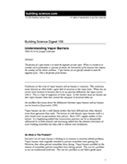Over the years there has been much debate as to when a vapor retarder or a vapor barrier should be used in a building. Perhaps the best way to answer this question is by understanding the reason vapor barriers are used in the first place and the mechanisms of moisture vapor movement.
Moisture vapor moves through building envelope in two ways: air transport and vapor diffusion. Air transport is by far the major vapor moisture flow mechanism of concern. Air leakage accounts for up to 90% of vapor moisture movement and is caused by warm, humid air exfiltrating through unintentional gaps in the building envelope. Vapor diffusion on the other hand, is the movement of water vapor through a material. Water vapor will diffuse through a material from air that is warmer and contains more moisture to air that is cooler and has less moisture. Moisture diffusion accounts for approximately 10% of vapor moisture movement. As you can see, air leakage is the main culprit for moisture vapor entering the building envelope.
The movement of moisture vapor in itself is not the need for concern. The problem arises when this moisture vapor is allowed to condense on a cold surface and turn to liquid water. This liquid water can lead to rotting of the structural elements of the building, provide a water source for unwanted insects, and create conditions favorable for the formation of mold within the building envelope. For this reason, builders began installing vapor retarders on the warm side of the wall to impede moisture from getting into the wall cavity. While it is correct to install this vapor retarder on the warm moisture laden side, it begs the question: What happens in the summer time when the air conditioner is running and the exterior side of the wall is now the warm side?
In a traditionally insulated fiberglass home, air leakage (due to the inability of the fiberglass to provide a complete air barrier) allows moisture laden interior air to reach the back of the cold exterior sheathing creating this unwanted condensation. When we use spray polyurethane foam, air leakage has been eliminated due to the complete air sealing properties of the insulation. Since we have eliminated the 90% of vapor moisture movement caused by air leakage from reaching the cold exterior sheathing, condensation fails to be the same problem. The tiny amount of moisture vapor being moved via vapor diffusion becomes small enough as to be insignificant in a typical home.
The other main problem with a vapor retarder is that once moisture does get into the cavity, it cannot readily escape. FoamRun generally recommends not using a vapor retarder when spray foam insulation is used. Although we do not use fiberglass in our projects, we would recommend a vapor retarder when fiberglass is used as the insulation (with some unique exceptions). This being said, there are times when we would suggest the use of a vapor retarder when using foam insulation in certain very unique circumstances when vapor drives are extreme (such as a cold storage facility).
Click on the article link above to see what Building Science Corporation has to say about the use of vapor barriers under varied conditions.

